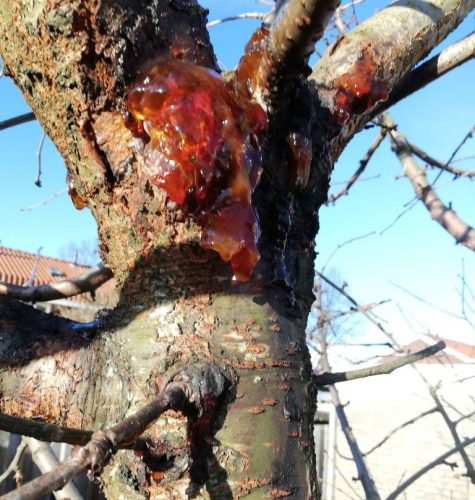Gummosis can be caused by pruning or it is a result of weakening of the tree.

Gummosis can be caused by pruning or it is a result of weakening of the tree. Gummosis is then a secondary infestation.
Stone fruit trees (cherry, plum, peach) are generally pruned after harvest. In winter, pruning makes the tree susceptible to fungus.
Stone fruit trees tolerate pruning only moderately. Excessive pruning makes the tree “bleed”: the tree oozes from the cuts. The moisture dries into a brown substance. In addition to pruning, wind and frost damage (cracks) can also cause forming of gummy sap on the damaged areas. These are equally entries of fungus and disease.
Trees affected by fungi and diseases are weakened, which can cause spontaneous formation of gummy sap. The peach tree is susceptible to Peach Leaf Curl (Taphrina deformans), and once weakened, gummosis often occurs. Abundant harvesting can also cause forming of gummy sap in peach trees.
Also in the Japanese cherry (Prunus serrulata), the formation of gum in various places on the trunk and branches is a result of infestation by bacterial canker (Pseudomonas syringae) and thus secondary.
Where to find
- Cherry
- Peach
- Japanese cherry
Control
Tricky to to control; a branch with gummosis can still be cut off. However, in trees where the formation of gummy sap is a result of fungus and disease, recovery is no longer possible.
Prevention
Prevent gummosis by limiting pruning and prevent the soil to become too acidic. Proper drainage also helps keep trees healthy. Be moderate with manure on stone fruit trees: over-fertilization encourages gum formation.
